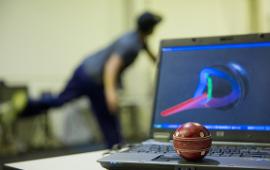Swinburne researchers develop new cricket ball to optimise training

In Summary
- Swinburne professor and PhD candidate develop smart cricket ball
- Draws on technology that works as a tool for understanding the mechanics of spin bowling
- Has the potential to make an impact on the way cricket is played
A smart cricket ball that could revolutionise cricket has been developed by Swinburne researchers. The smart ball uses first-of-its-kind technology as a tool for understanding the mechanics of spin bowling and is being used to optimise spin bowling training.
Until now, the only way for coaches to analyse spin bowlers’ techniques was through video analysis.
The ball has been developed by Swinburne’s Professor Franz Konstantin Fuss and PhD candidate Batdelger Doljin, with assistance from Dr Rene Ferdinands, an ex-first class cricketer and current coach.
Through a combined effort of Professor Fuss’ technical understanding of the technology and Dr Ferdinands’ in-depth cricket knowledge, they have been able to interpret data from the ball and identify up to seven key parameters that are integral to refining spin bowlers’ techniques.
“Any serious cricket academy should have access to this ball. Spin bowling is such an important part of the game” said Dr Ferdinands.
As well as analysing the spin-rate of a bowl, the smart ball data shows the precession, torque, efficiency and the centre of pressure on the ball.
These previously invisible factors have already made a huge impact on the way Dr Ferdinands coaches cricketer, Clive Rose.
“Clive has more variations than any other international finger-spin bowler in the world today and is capable of reaching a standard to play at an international level,” said Dr Ferdinands.
After coaching Mr Rose for the past two months, Dr Ferdinands says he can already see a vast improvement in performance through the training program that combines data from the smart ball with the latest advances in spin bowling biomechanics.
Analysing the data
To date, there were up to eight different types of spin bowl deliveries that were known to cricketers and coaches.
Dr Ferdinands has been able to identify a further twelve bowling types through analysis of the smart ball data and biomechanics and believes there could be as many as 25 variations.
While the number of spin variations are not currently mainstream knowledge, Dr Ferdinands believes the use of the smart ball in training could identify new types of deliveries that can make a big impact on the game.
The data taken from the ball could also help coaches to quickly identify the exact level of natural talent of a bowler and then go on to refine those skills further.
Understanding the technology
The current smart ball prototype is the exact regulation weight and size of a traditional cricket ball and all the data is extracted completely wirelessly.
The three digital gyroscopes within the ball make it possible to capture the highly detailed data, which is interpreted by Dr Ferdinands and applied in training.
As well as the significant impact on spin bowlers training, the smart ball has the capacity to transform spectators’ viewing experience of cricket.
Professor Fuss says the ultimate goal would be to have a smart ball that can be used in games to relay key statistics about what type of delivery is bowled in real time on screen.
“With a little bit of proper explanation, even a child can understand the technology and use it to share their performance parameters with friends all over the world,” says Professor Fuss.
Professor Fuss is currently working on an app that will allow the complex technology behind the smart ball to be accessible for anyone.

